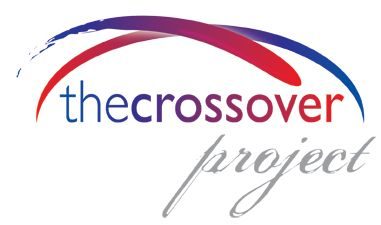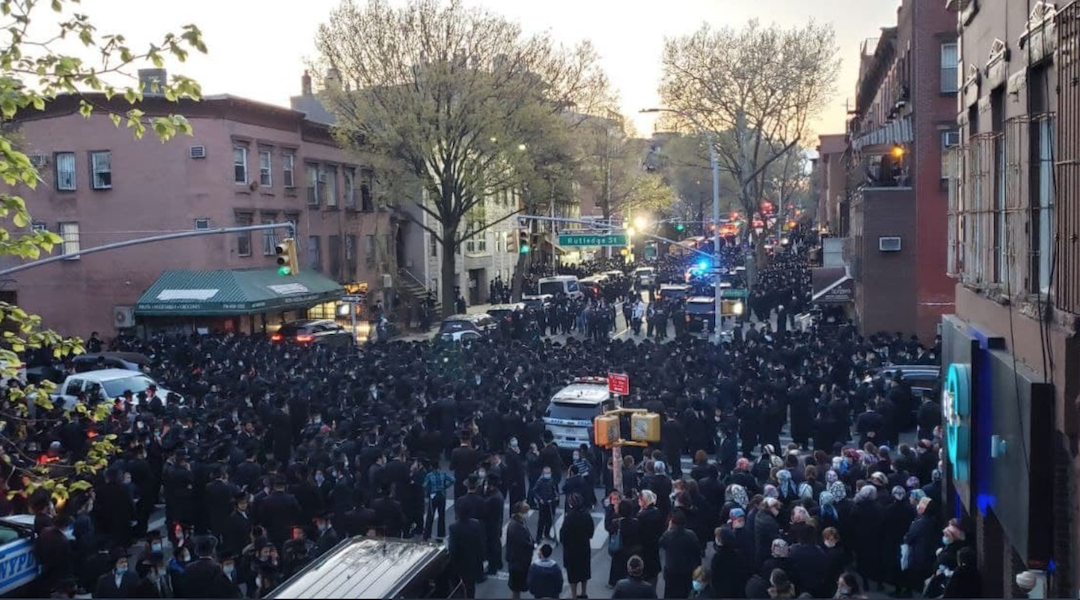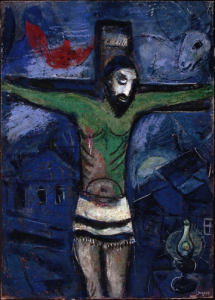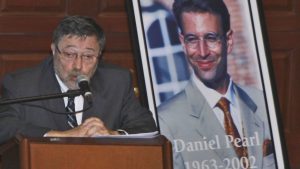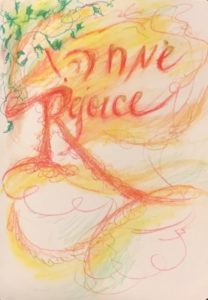In calling out failure to social distance, the New York City mayor misleadingly conflates all Jews with Hasidim.
By BEN ADLER APRIL 29, 2020
New York City Mayor Bill de Blasio came under an onslaught of criticism on Tuesday night when he tweeted his reaction to the overcrowded funeral procession for a rabbi from the Satmar Hasidic sect of ultra-Orthodox Jews. The first tweet called the crowd that had in South Williamsburg, in violation of statewide bans on gatherings of 10 or more people, “unacceptable.” But de Blasio’s subsequent message sent Twitter into a spasm of rage because it began, “My message to the Jewish community, and all communities, is this simple: the time for warnings has passed. I have instructed the NYPD to proceed immediately to summons or even arrest those who gather in large groups.”
The mayor of the most Jewish major city outside of Israel was then widely derided as an anti-Semite who is looking to start a second Holocaust. “Oh look everyone, the Democrat Mayor of New York is an anti-semite who wants to round up Jewish People like hitler did,” began the hysterical response from conservative media personality Tim Young, which gathered thousands of likes and retweets. De Blasio even brought together left and right. Young concluded, “I won’t wait up for the outrage from the left” – but, in fact, plenty of online progressives criticized de Blasio for, as one put it, “singling out the Jewish community, blaming an entire religion for actions of a few, for threatening to round us up.”

All of these critics are right to fault de Blasio for singling out “the Jewish community,” but they are right for the wrong reason. The problem with de Blasio’s tweet isn’t that he dared to speak directly to a community that flouted social distancing regulations, which are needed to stem the spread of COVID-19. The problem is that he conflated a group within a small, idiosyncratic sect of ultra-Orthodox Jews with all 1.1 million Jews in New York City – an offensive error he repeated in a press conference on Wednesday.
First a primer, for the apparently ignorant mayor’s benefit: American Jews are significantly less likely than the general public to say religion is important in their lives or to regularly attend religious services, according to Pew Research Center polling. Politically, as The Washington Post notes, “American Jews are disproportionately clustered on the liberal/Democratic side of the political spectrum.” Only 10% of American Jews are Orthodox, although 40% of New York City Jews are. When it comes to religion and politics, Pew observes, “Orthodox Jews more closely resemble white evangelical Protestants than they resemble other U.S. Jews.”
Within that subset are the extremely conservative ultra-Orthodox, who live in close-knit communities that often eschew secular culture – no TV, no web browsing – and adhere to very strict social norms around marriage and courtship and so on. Whereas Jews as a whole are more educated and higher-earning than the general public, ultra-Orthodox Jews are typically less educated and more likely to live in poverty. Hasidim are a subset of the ultra-Orthodox who belong to sects that each have their certain unique beliefs and practices – the Satmars, for instance, are anti-Zionist. Even among Hasidim, there are multiple communities: The Lubavitchers are distinct from the Satmars, who are themselves divided between communities that follow rival brothers.
There are also ethnic variations among New York City Jews: Russian-American Ashkenazi Jews are not exactly the same as Uzbekhi-American Bukharian Jews, and they are different from Sephardic “Syrian Jews” and so on.
So there is no singular “Jewish community,” but de Blasio directed his response to the actions of one non-representative, extremist group to all of New York Jewry. “Certainly the Mayor is smart enough to know the full breadth and diversity of the Jewish community in New York, and should not have used such a sweeping description for the actions of a subset of the Hasidic community, much less the entire Jewish community as a whole,” wrote Doug Forand, a New York-based Democratic strategist, in an email to City & State. “I don’t believe his intentions were to be anti-Semitic, but using this type of unfortunate choice of words does give anti-Semites more fodder for their hateful rhetoric, and he should know better.”
While many on Twitter seem to believe that it’s bigoted scapegoating to say anything at all about what happened in Williamsburg, there are legitimate concerns about the failure to social distance among some ultra-Orthodox communities in Brooklyn. As Gothamist reported earlier this month, the NYPD has repeatedly had to break up Hasidic funerals in Williamsburg and Borough Park – neighborhoods that have been especially hard-hit by the coronavirus pandemic. There’s nothing inherently wrong with confronting that issue directly.
But there’s something very wrong with taking the actions of some members of one Hasidic sect and imputing them to 13% of New Yorkers spread all across five boroughs. Can anyone imagine de Blasio lazily tarring any other religion with the actions of a fringe group? Suppose it had been the Amish – would de Blasio direct his response to “the Christian community?”
One might be tempted to give de Blasio a pass for not knowing about the manifold Jewish communities, were it not for the fact that he has lived in New York City and worked in New York politics for his entire adult life, represented part of Borough Park on the City Council, held citywide office for 15 years, and been elected citywide four times. Also – and perhaps this has something to do with why de Blasio used such wildly overbroad, misleading language – he’s a longtime ally of the ultra-Orthodox. Whether it’s repealing public health regulations on circumcision rituals or slow-walking any effort to make their religious schools teach secular subjects, de Blasio has been happy to oblige the requests of leading ultra-Orthodox rabbis. And their communities have repaid him in kind, donating, for instance, to his ill-fated presidential campaign.
In fact, de Blasio’s favoritism for the Hasidim may have contributed to the funeral crowd’s existence in the first place. As Gothamist reported, “according to Hasidic community leaders, the police department actually approved and helped coordinate the procession …. A police spokesperson would not say why the funeral was allowed to take place, or how the department decides to enforce social distancing laws.”
Maybe the mayor has grown so close to the ultra-Orthodox leadership that he’s forgotten about the existence of all other Jews in the city. “This is the most visible Jewish community,” said one former de Blasio speechwriter, who requested anonymity to theorize about the mayor’s intentions. “It’s the one he knows best. He interacts with them the most. He has a long history with them. So it was easy for him to not be careful with his language, and to mistake one part for the whole.”
The de Blasio administration denies that his political relationship with Hasidic communities in Brooklyn had anything to do with his response. “He was upset and tweeted an impassioned message,” wrote de Blasio’s press secretary Freddi Goldstein. “He did so out of concern for the health and safety for the ultra-Orthodox community and concern for the health and safety of all New Yorkers. There was no time spent considering a voting bloc.”
However relevant it is to the current controversy, de Blasio’s transactional relationship with ultra-Orthodox Jews has been criticized by many more liberal Jewish New Yorkers. “He has been a friend to (the ultra-Orthodox) when it has been convenient,” said Ester Fuchs, a professor of public affairs at Columbia University and a former advisor to ex-Mayor Michael Bloomberg who is Modern Orthodox. “He was perfectly happy to sacrifice the health and educational well-being of kids in these communities when it was valuable to his reelection.”
If anything, some might say, de Blasio should be applauded for confronting his allies – had he called them out by name instead of unfairly maligning a bunch of unrelated people.
Fuchs, however, argues that a unifying leader wouldn’t have made it about any single group at all. “This is an isolated incident now,” said Fuchs about the rabbi’s funeral. Fuchs added that compliance with social distancing regulations in ultra-Orthodox communities “have really improved dramatically,” compared to early on in the crisis when word had not gotten out to the isolated Hasidic communities. “(De Blasio) spoke about it as if this was representative of the entire Hasidic and Haredi community and the entire Jewish community,” said Fuchs, who is a member of the board of the Jewish Community Relations Council. “It’s not effective leadership. Singling out communities is not the way to go here, period. As the city leader, he needs to be more careful with his language.”
City Hall did not directly answer questions as to why de Blasio used the language he did. Initially, Goldstein, the mayoral spokeswoman, simply defended his making the statement and directed City & State to review the mayor’s Wednesday press conference.
In that press conference, de Blasio referred repeatedly to the Satmar Hasidim from one synagogue who filled the street on Tuesday as “the Jewish community” and “the Orthodox community.” He did not explain at all why he chooses to portray a mostly secular, liberal and assimilated cohort of New Yorkers as coterminous with a sharply segregated, intensely devout, theologically unique sect. When pressed on why the mayor was doing so, Goldstein wrote in an email to City & State, “As the mayor said, he tweeted in the heat of the moment. He was very frustrated by what had gone on and moved quickly to get his message out. He apologizes to anyone he has offended – that certainly was not his intention.” However, he wasn’t “in the heat of the moment” at the press conference a day later, and yet he continued to offend.
In fairness, de Blasio is not the only one who uses this sloppy, misleading terminology. News outlets that should know better, from lowbrow local tabloids to upper middlebrow national magazines and the self-proclaimed “newspaper of record” do the same. Consider the New York Post’s story on the funeral, which reported, “Mayor Bill de Blasio criticized the Jewish community in Williamsburg,” after “hundreds of Orthodox Jews gathered in the streets near the intersection of Rutledge Street and Bedford Avenue to pay their respects for the rabbi.”
What Jewish community in Williamsburg? The many hipsters who happen to be Jewish and live in the neighborhood? Orthodox Jews like Jared Kushner and Ivanka Trump?
No, and no. They mean the Satmar Hasidic sect of ultra-Orthodox Jews, specifically, and they should say so.
There are real consequences to this inaccuracy. The failure by media and elected officials to accurately distinguish between Hasidim and other Jews led to the widespread, false assumption among New Yorkers, including de Blasio, that the spate of anti-Semitic hate crimes last year was the work of far-right hooligans, presumably influenced by President Donald Trump’s friendliness with white nationalists.
In fact, the victims of most of the attacks were Hasidim in Hasidic neighborhoods, and the perpetrators were mostly African Americans and Latinos from adjacent communities. In other words, instead of white Trump voters attacking mostly liberal Jews for not being really white, it was non-white New Yorkers attacking Trump-supporting ultra-Orthodox Jews.
On Wednesday, the Jewish Community Relations Council issued a statement noting, in part, “This was a single event, planned by one congregation.” The mayor, however, isn’t listening. “Members of the Jewish community were putting each other in danger,” de Blasio said Wednesday. “They were putting our police officers in danger.” It will come as a surprise to secular Jews from the Upper West Side to de Blasio’s own beloved Park Slope, Brooklyn, to learn that their “community” did anything of the sort.
